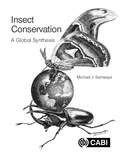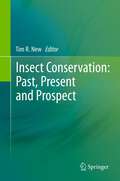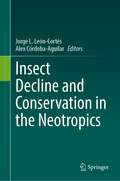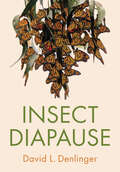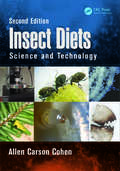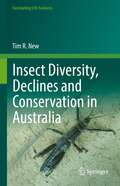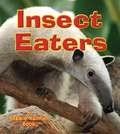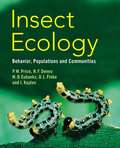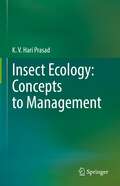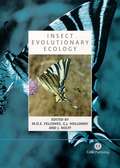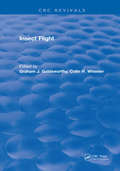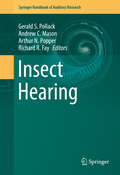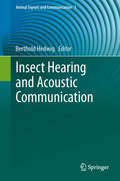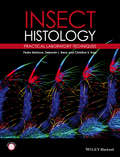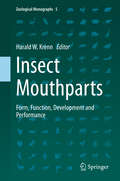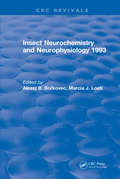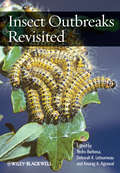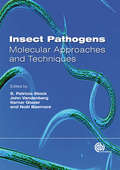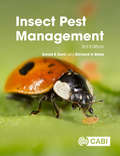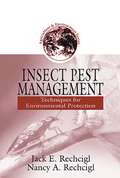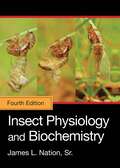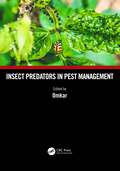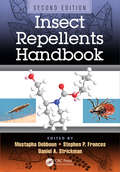- Table View
- List View
Insect Conservation: A Global Synthesis (Techniques In Ecology And Conservation Ser. #Vol. 2)
by Dr Michael J. SamwaysInsect Conservation: A Global Synthesis is a landmark, field-defining work written by Professor Michael Samways, one of the founding fathers of this burgeoning discipline of conservation science. This book presents a state-of-the-art, comprehensive review of the entire field of insect conservation, from single-species conservation to whole-ecosystem approaches, and from natural ecosystems to the urban landscape. The variety and number of insects are truly vast. They are the most speciose group of organisms on Earth, with the majority barely known to science or still not described at all. They are a vital component in all terrestrial ecosystems, which would fail to function normally without them. Insect populations worldwide, however, are under threat. Human-mediated degradation of natural habitats, pollution, over-use of pesticides, and the spread of urbanization has led to the collapse of insect populations in many areas of the world. A growing recognition of the importance of insects in natural and agricultural systems has stimulated the development of an entire discipline dedicated to their conservation. Insect Conservation: A Global Synthesis is designed to be used by students of conservation biology and ecology, but also serves as an essential overview for professional entomologists with an interest in conservation, and for conservationists interested in insects. The book communicates on three levels: (i) through the text, with extensive references providing a gateway to the ever-increasing primary literature; (ii) through the extensive use of carefully constructed illustrations, with detailed captions which act to summarize the text and are complete in their own right; and (iii) through focused key points at the end of every chapter, which summarise the main learning points for students.
Insect Conservation: Past, Present and Prospects
by Tim R. NewThe history of interest and practice in insect conservation is summarised and traced through contributions from many of the leaders in the discipline, to provide the first broad global account of how insects have become incorporated into considerations of conservation. The essays collectively cover the genesis and development of insect conservation, emphasising its strong foundation within the northern temperate regions and the contrasts with much of the rest of the world. Major present-day scenarios are discussed, together with possible developments and priorities in insect conservation for the future.
Insect Decline and Conservation in the Neotropics
by Jorge L. León-Cortés Alex Córdoba-AguilarThis book provides for the first time an integrative analysis of the major drivers of decline and threats of insects and related arthropods in the Neotropical region. Thus, it is an urgent first step towards filling an information gap in this region. It identifies the main causes of decline, provides and discusses examples from the better-studied insect faunas to develop and advance principles and practical conservation management for the rich Neotropical insect faunas. The book is aimed at students, naturalists, environmental managers, and others who have training in entomology/insect ecology and can apply the results of surveys of key insect faunas to assess their vulnerability to environmental change and establish guidelines for their conservation.
Insect Diapause
by David L. DenlingerOur highly seasonal world restricts insect activity to brief portions of the year. This feature necessitates a sophisticated interpretation of seasonal changes and enactment of mechanisms for bringing development to a halt and then reinitiating it when the inimical season is past. The dormant state of diapause serves to bridge the unfavourable seasons, and its timing provides a powerful mechanism for synchronizing insect development. This book explores how seasonal signals are monitored and used by insects to enact specific molecular pathways that generate the diapause phenotype. The broad perspective offered here scales from the ecological to the molecular and thus provides a comprehensive view of this exciting and vibrant research field, offering insights on topics ranging from pest management, evolution, speciation, climate change and disease transmission, to human health, as well as analogies with other forms of invertebrate dormancy and mammalian hibernation.
Insect Diets: Science and Technology, Second Edition
by Allen Carson CohenDr. Allen Carson Cohen's new edition of Insect Diets: Science and Technology continues to provide a current, integrated review of the field of insect diets. It reaffirms and expands upon the belief that the science of diet development and the technology of diet application in rearing programs require formal foundations and guidelines. Cohen argues
Insect Diversity, Declines and Conservation in Australia (Fascinating Life Sciences)
by Tim R. NewProblems of insect enumeration and assessment of needs are addressed in the contexts of rapid and substantial losses and changes to all key Australian terrestrial and freshwater environments and promoting awarenesss of the importance of insects. Further definition of the insect fauna and its peculiarities can aid threat alleviation and practical management to protect and conserve this unique and largely endemic biodiversity. Written for the many environmental managers and naturalists who are not primarily entomologists, the ten chapters expand from considerations of insect decline and diversity to the unique features of the Australian fauna and its characterisation. Cases and examples from throughout the world illustrate the major needs, approaches and priorities to sustaining a poorly known, diverse and ecologically varied insect heritage of global significance.
Insect Eaters (Big Science Ideas)
by Bobbie KalmanMany animals are carnivores, but some eat mainly insects. Insect eaters, known as insectivores, can be as small as insect-eating insects or as large as giant anteaters. Covers a variety of plants and animals that eat insects, from frogs and birds to pitcher plants and anteaters.
Insect Ecology
by Deborah L. Finke Peter W. Price Ian Kaplan Robert F. Denno Micky D. EubanksCombining breadth of coverage with detail, this logical and cohesive introduction to insect ecology couples concepts with a broad range of examples and practical applications. It explores cutting-edge topics in the field, drawing on and highlighting the links between theory and the latest empirical studies. The sections are structured around a series of key topics, including behavioral ecology; species interactions; population ecology; food webs, communities and ecosystems; and broad patterns in nature. Chapters progress logically from the small scale to the large; from individual species through to species interactions, populations and communities. Application sections at the end of each chapter outline the practicality of ecological concepts and show how ecological information and concepts can be useful in agriculture, horticulture and forestry. Each chapter ends with a summary, providing a brief recap, followed by a set of questions and discussion topics designed to encourage independent and creative thinking.
Insect Ecology: Behavior, Populations and Communities
by Deborah L. Finke Peter W. Price Ian Kaplan Robert F. Denno Micky D. Eubanks"Combining breadth of coverage with detail, this logical and cohesive introduction to insect ecology couples concepts with a broad range of examples and practical applications. It explores cutting-edge topics in the field, drawing on and highlighting the links between theory and the latest empirical studies. The sections are structured around a series of key topics, including behavioral ecology; species interactions; population ecology; food webs, communities and ecosystems; and broad patterns in nature. Chapters progress logically from the small scale to the large; from individual species through to species interactions, populations and communities. Application sections at the end of each chapter outline the practicality of ecological concepts and show how ecological information and concepts can be useful in agriculture, horticulture and forestry. Each chapter ends with a summary, providing a brief recap, followed by a set of questions and discussion topics designed to encourage independent and creative thinking"--
Insect Ecology: Concepts to Management
by K. V. PrasadThis book presents comprehensive information on various aspects of ecology with special reference to insects, to form a platform to design an ecologically sound insect pest management. Insects are the most dominant and diverse group of living organism on earth. Owing to their smaller size, smaller space and food requirements, more number of generation per unit time, insects serves as one of the best subject matter for studies on various ecological aspects such as chemical ecology, population dynamics, predator/parasitoid-prey interactions etc. The knowledge on various aspects of insect ecology helps in formulating an effective environmentally benign insect pest management. This book is of interest and use to the post graduate students and researchers working on various aspects of insect ecology with special emphasis on population dynamics, chemical ecology, tri tropic interactions, ecological engineering and Ecological Insect pest management.
Insect Evolutionary Ecology: Proceedings of the Royal Entomological Society's 22nd Symposium
by J. Rolff J. G. Holloway M. D. E. FellowesInsects provide excellent model systems for understanding evolutionary ecology. They are abundant, small and relatively easy to rear, and these traits facilitate both field and laboratory experiments. This book has been developed from the Royal Entomological Society's 22nd International Symposium, held in Reading in 2003. Topics include speciation and adaptation; life history, phenotype plasticity and genetics; sexual selection and reproductive biology; insect-plant interactions; insect-natural enemy interactions and social insects.
Insect Flight
by Graham J. GoldsworthyInsects are the most numerous class of animals or earth, both in terms of their number and their variety. There are 800,000 recognized species, with between 1 and 10 million estimated species yet to be classified. This book will discuss, mechanics of flight, Wing structure, Hovering flight, flight in smaller and larger insects and wing polars.
Insect Hearing
by Richard R. Fay Gerald S. Pollack Andrew C. Mason Arthur N PopperInsect Hearing provides a broadly based view of the functions, mechanisms, and evolution of hearing in insects. With a single exception, the chapters focus on problems of hearing and their solutions, rather than being focused on particular taxa. The exception, hearing in Drosophila, is justified because, due to its ever growing toolbox of genetic and optical techniques, Drosophila is rapidly becoming one of the most important model systems in neurobiology, including the neurobiology of hearing. Auditory systems, whether insectan or vertebrate, must perform a number of basic tasks: capturing mechanical stimuli and transducing these into neural activity, representing the timing and frequency of sound signals, distinguishing between behaviorally relevant signals and other sounds and localizing sound sources. Studying how these are accomplished in insects offers a valuable comparative view that helps to reveal general principles of auditory function.
Insect Hearing and Acoustic Communication
by Berthold HedwigThis volume provides a comprehensive selection of recent studies addressing insect hearing and acoustic communication. The variety of signalling behaviours and hearing organs makes insects highly suitable animals for exploring and analysing signal generation and hearing in the context of neural processing, ecology, evolution and genetics. Across a variety of hearing species like moths, crickets, bush-crickets, grasshoppers, cicadas and flies, the leading researchers in the field cover recent scientific progress and address key points in current research, such as: - How can we approach the evolution of hearing in insects and what is the developmental and neural origin of the auditory organs? - How are hearing and sound production embedded in the natural lifestyle of the animals, allowing intraspecific communication but also predator avoidance and even predation? - What are the functional properties of hearing organs and how are they achieved at the molecular, biophysical and neural levels? - What are the neural mechanisms of central auditory processing and signal generation? The book is intended for students and researchers both inside and outside of the fascinating field of bioacoustics and aims to foster understanding of hearing and acoustic communication in insects.
Insect Histology
by Pedro Barbosa Christina K. Kary Deborah BerryThis title is a much needed update of Barbosa's self-published Manual of Basic Techniques in Insect Histology. It is a laboratory manual of 'traditional' and 'modern' insect histology techniques, completely revised using cutting-edge methodology carried out today and includes new immunohistochemical techniques not previously looked at.Insect Histology is designed as a resource for student and professional researchers, in academia and industry, who require basic information on the procedures that are essential for the histological display of the tissues of insects and related organisms.
Insect Media: An Archaeology of Animals and Technology (Posthumanities #11)
by Jussi ParikkaSince the early nineteenth century, when entomologists first popularized the unique biological and behavioral characteristics of insects, technological innovators and theorists have proposed insects as templates for a wide range of technologies. In Insect Media, Jussi Parikka analyzes how insect forms of social organization-swarms, hives, webs, and distributed intelligence-have been used to structure modern media technologies and the network society, providing a radical new perspective on the interconnection of biology and technology.Through close engagement with the pioneering work of insect ethologists, including Jakob von Uexküll and Karl von Frisch, posthumanist philosophers, media theorists, and contemporary filmmakers and artists, Parikka develops an insect theory of media, one that conceptualizes modern media as more than the products of individual human actors, social interests, or technological determinants. They are, rather, profoundly nonhuman phenomena that both draw on and mimic the alien lifeworlds of insects. Deftly moving from the life sciences to digital technology, from popular culture to avant-garde art and architecture, and from philosophy to cybernetics and game theory, Parikka provides innovative conceptual tools for exploring the phenomena of network society and culture. Challenging anthropocentric approaches to contemporary science and culture, Insect Media reveals the possibilities that insects and other nonhuman animals offer for rethinking media, the conflation of biology and technology, and our understanding of, and interaction with, contemporary digital culture.
Insect Mouthparts: Form, Function, Development and Performance (Zoological Monographs #5)
by Harald W. KrennThis is the first comprehensive book focusing on the form and function of insect mouthparts. Written by leading experts, it reviews the current knowledge on feeding types and the evolution of mouthparts and presents new research approaches. The richly illustrated articles cover topics ranging from functional morphology, biomechanics of biting and chewing, and the biophysics of fluid-feeding to the morphogenesis and genetics of mouthpart development, ecomorphology in flower-visiting insects as well as the evolution of mouthparts, including fossil records. Intended for entomologists and scientists interested in interdisciplinary approaches, the book provides a solid basis for future scientific work. Chapter 6 of this book is available open access under a CC BY 4.0 license at link.springer.com.
Insect Neurochemistry and Neurophysiology
by Alexej B. BorkovecThis book represents proceedings from ICINN 1993, and comprises papers on nerve function, neurotransmitters, ion channels, second messengers and neuropeptides. By using a variety of techniques, combining aspects of nrurophysiology, pharmacology, immunology, peptide separation and sequencing or molecular biology, it has become possible to study systems in greater detail and complexity than before.
Insect Outbreaks Revisited
by Pedro Barbosa Anurag Agrawal Deborah LetourneauThe abundance of insects can change dramatically from generation to generation; these generational changes may occur within a growing season or over a period of years. Such extraordinary density changes or "outbreaks" may be abrupt and ostensibly random, or population peaks may occur in a more or less cyclic fashion. They can be hugely destructive when the insect is a crop pest or carries diseases of humans, farm animals, or wildlife. Knowledge of these types of population dynamics and computer models that may help predict when they occur are very important.This important new book revisits a subject not thoroughly discussed in such a publication since 1988 and brings an international scale to the issue of insect outbreaks.Insect Outbreaks Revisited is intended for senior undergraduate and graduate students in ecology, population biology and entomology, as well as government and industry scientists doing research on pests, land managers, pest management personnel, extension personnel, conservation biologists and ecologists, and state, county and district foresters.
Insect Pathogens: Molecular Approaches and Techniques
by S. Patricia Stock John Vanderberg Noël Boemare Itamar GlazerThe book is essential reading for those studying and researching at the forefront of molecular science and biological management and is divided into four sections covering: Identification and Diagnostics, Evolutionary Relationships and Population Genetics, Genomics, and Genetic Engineering.
Insect Pest Management
by David Dent Dr Richard BinksAn undergraduate and postgraduate textbook covering the key principles, methodologies, approaches and practical examples of insect pest management in agricultural, post harvest systems, horticulture, insect vectors and medical and veterinary entomology. The book covers the underpinning monitoring and forecasting of pest outbreaks, yield loss and impact assessments and all of the latest methods of control and management of insects from insecticides, host manipulation, plant resistance, biological control, use of interference, agronomic and precision control methods as well as socio-economic and research management aspects of developing integrated approaches to pest management. The new edition also reflects the key advances made in the disciplines of molecular biology, biochemistry and genomics related to insects and their management, as well as the importance and role of biodiversity, climate change, precision agriculture, data management and sustainability of production and supply in delivering integrated management solutions.
Insect Pest Management: Techniques for Environmental Protection
by Jack E. Rechcigl Nancy A. RechciglInsect pest control continues to be a challenge for agricultural producers and researchers. Insect resistance to commonly used pesticides and the removal of toxic pesticides from the market have taken their toll on the ability of agricultural producers to produce high quality, pest-free crops within economical means. In addition to this, they must
Insect Physiology and Biochemistry
by James L. Nation, Sr.Employing the clear, student-friendly style that made previous editions so popular, Insect Physiology and Biochemistry, Fourth Edition presents an engaging and authoritative guide to the latest findings in the dynamic field of insect physiology. The book supplies a comprehensive picture of the current state of the function, development, and reproduction of insects. Expanded and updated, now in full colour, this fourth edition adds three new chapters on the role of the nervous system in behavior; the ‘Genomics Revolution’ in entomology; and global climate changes which have a major effect on insects, including warming and weather. It continues to challenge conventional entomological wisdom with the latest research and analytical interpretations. The text will appeal to upper undergraduate and graduate students and to practicing biologists who need to possess a firm knowledge of the broad principles of insect physiology. With detailed full colour illustrations to help explain physiological concepts and important anatomical details, it remains the most easily accessible guide to key concepts in the field.
Insect Predators in Pest Management
by OmkarPests cause damage to the economic value of crops and stored products, while vectors are responsible for the transmission of disease-causing agents in human beings and livestock. Although application of synthetic pesticides in agriculture gives immediate relief, it also causes well-known side effects, leading to a consensus among entomologists and agriculturists to shift towards other ecofriendly pest management methods. Natural enemies of insects including their predators, parasitoids and pathogens have attracted the attention of scientists across the globe. These natural enemies exist in agroecosystems and suppress the populations of pests. Parasitoids are farmers’ friends and the most successful group of natural enemies. Highly specialized/generalized in their prey choice, active stages of predators search for a suitable prey, attack or kill the prey and consume prey within a short handling time. Predatory ability is known to increase with increase in prey density. A single predator may devour several prey individuals. Exploiting this potency of parasitoids may yield successful results in controlling notorious pests in an ecofriendly way. This book provides information on the important biocontrol agents that are effective in pest suppression. It starts with insect parasitic groups followed by specific group of parasitoids. It is hoped that the book presents a comprehensive account of beneficial parasitoids and will be useful to undergraduate and postgraduate students of Entomology, Biological Control, Plant Protection, Agricultural Zoology and Zoology, besides those involved in competitive examinations and policy planning. Features Each chapter has been authored by specialized senior professionals. Every chapter contains Learning Objectives and Points to Remember. This book offers comprehensive knowledge of parasitoids and their application in pest management in a lucid way.
Insect Repellents Handbook
by Mustapha Debboun Stephen P. Frances Daniel A. StrickmanThe public has a great desire for products that prevent the annoyance of biting insects and ticks, but that desire does not always translate into sensible use of those products. Insect Repellents Handbook, Second Edition summarizes evidence-based information on insect repellents to inform decisions by those involved with insect repellent research,
